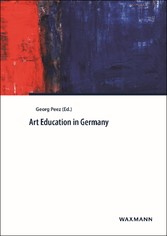Suchen und Finden
Service
Contents
5
Art Education “Made in Germany” (Georg Peez)
9
“Glocal” Diversity
9
Educational Federalism in Germany
10
Ties to German-speaking Neighboring Countries
10
The Book’s Structure
11
How Contributions Were Sourced
12
Acknowledgements
12
Historical and Current Concepts. Aspects of Art Education in Germany after 1945 (Marc Fritzsche, Martin Klinkner & Georg Peez)
15
Image Orientation
16
Art Orientation
17
Subject Orientation
17
Art Education in Primary Schools (Constanze Kirchner)
21
Abstract
21
Tasks and Objectives of Art Class
21
Aesthetic Interest and Aesthetic Experience
21
Experiencing Nature and Compensation
22
Visual Design
23
Experiencing Environment and Play
23
Perception and Creativity
25
Media Literacy
25
Experiencing Art
26
Performance Evaluation
27
References
28
Opening Spaces for Opportunities. Staging Materials as an Art Educational Intervention (Petra Kathke)
29
Abstract
29
Setting Materials – A Field for Playing and Practicing
30
Intended Inspiration
31
“Artificial Marking” as a Didactical Impulse
32
Material Staging as an Action Analogous to Art
34
References
34
Open Dialogues in the Art Workshop. Nobody Knows What It Will Turn out to Be (Thomas Heyl)
35
Abstract
35
The Art Studio – A School of Fantasy
36
Multiple Dialogues
37
Room and Space
40
All-day
40
References
41
Integrated Arts and Computer Science Education in Mixed Reality Learning Spaces (Daniela Reimann)
43
Fan Art – Online Youth Aesthetics in the Art Classroom (Jutta Zaremba)
49
Fan Art Sections
49
Fan Art Giant ANIMEXX
50
Continuous Improvement through Tutorials
51
Contests and Comments as Motivation
51
Expertise, Self-Education and Social Communication in the Art Classroom
52
References
54
For a Sociospatial Practice of Art Education (Ulrike Stutz)
57
Abstract
57
Sociospatiality Seen Through Procedural Space Theories
57
Communication Sculptures – Art as a Space-Creating Process
58
Transformative and structural education processes
58
Qualitative Empirical Analysis
60
References
61
Artistic Education Within Art Projects (Carl-Peter Buschkühle)
65
Abstract
65
The Turning Point in German Art Education
65
The Art Project as a Practice of Art Education
66
Elements of Art-Oriented Art Education
68
Goal: Artistic Thinking
70
References
71
Image Orientation and Art Education (Rolf Niehoff)
73
Abstract
73
A Short Review
73
On the Current Cultural Situation
73
The School Subject of Art as the “Subject of Images”
74
What Does “Image Competences” Mean?
74
Summary
77
References
78
Art Class or Image Class? Remarks on Naming a School Subject (Dietrich Grünewald)
79
The Extended Art Space. The Web as a Sphere of Action (Sara Burkhardt)
83
Abstract
83
Reality and Imagination
84
Exposure – Production – Reflection
85
Communication and Cooperation
86
Intersections
88
Outlook
88
References
89
Methods of Evaluation and Grading in Art Class (Georg Peez)
91
Abstract
91
1. Criteria- or Category-Based Evaluation Methods, Frequently Used With Credit and Numerical Scales
91
2. Evaluation Methods Based on Evidence Assessment
93
3. Evaluation Methods Within Progressive and Open Art Classes
94
Conclusion
96
References
97
Color and Space. Two Competing Parameters of Our Perception (Martin Oswald)
101
Abstract
101
The Change of Color Perception Between the Ages of Eleven and Sixteen
102
Explanations of the Visual System
105
Conclusions for Art Education
107
References
107
The Experiment in Art Class (Thomas Michl)
109
Abstract
109
A General Structural Layout of the Experiment
109
Several Didactical Consequences of Experimenting in Art Class
109
Supporting Conditions and Classroom Setting for Experimentation
109
The Planning of Topics and Contents for the Experiment
110
The Importance of the Experimenting Classroom as a Social Setting
111
Classroom Guidance and the Experimental Attitude of the Teacher
112
The Dual Nature of the Experiment
113
References
114
Art Education and Biography (Georg Peez)
115
Abstract
115
Research Questions
115
Results
116
(1) Biographical Aspects: Childhood, Schooldays and Youth
116
(2) The Approach to a Profession in Education and the School
118
(3) Attitudes Towards Art Class
118
(4) The Concepts of Art Education as a Background for Art Educational Practice
120
Conclusion
121
References
121
Play and Language (Johannes Kirschenmann)
125
Abstract
125
Playful Reconstructions
126
Language Educates – As Does Artistic Play
127
References
129
Aesthetic Delight (Michael Parmentier)
131
Play (Gundel Mattenklott)
137
The Road Towards Intercultural/Transcultural Arts Education (Ernst Wagner)
141
BDK – Association for Art Education (Marc Fritzsche & Martin Klinkner)
149
Aims of BDK – Association for Art Education
149
Images for Education
149
Sources
150
Databases and Further Resources. Publications in National and International Contexts
151
Authors
153
Alle Preise verstehen sich inklusive der gesetzlichen MwSt.










